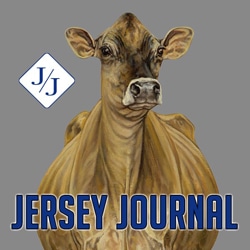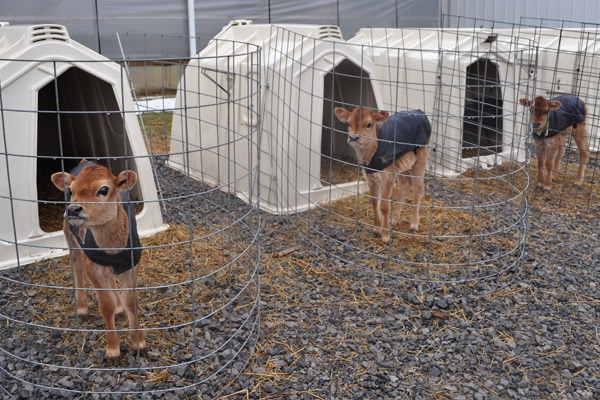Tips to Raise Healthier Jersey Calves
More and more, Jerseys are being integrated into Holstein herds, largely due to their higher milk components and advantages in feed and reproductive efficiencies.
Though familiar with raising and milking Holsteins, dairy producers often have questions about Jerseys. By paying mind to a few key breed differences, they will be poised to capitalize on Jersey potential.
One area in which Jerseys and Holsteins differ is management of newborns and baby calves. Keep these key points in mind when working with Jerseys:
- Jersey newborns are relatively small, averaging 60 lbs., and have minimal body fat reserves of just 3%. This is quickly expended to generate body heat, often within hours of birth.
- Body heat dissipates more quickly in Jersey calves because of their high ratio of body surface area to body mass. Because of this, they can be more prone to chilling and dehydration.
- Jerseys have a higher maintenance requirement per unit of metabolic weight. They are not simply a “smaller” breed of dairy cattle.
To help you care for the beautiful brown babies in your calf pens, we have compiled the following tips from nutritionists who specialize in Jerseys and resources at the American Jersey Cattle Association. For a printable PDF of this post as published in the November 2020 issue of the Jersey Journal, click here.
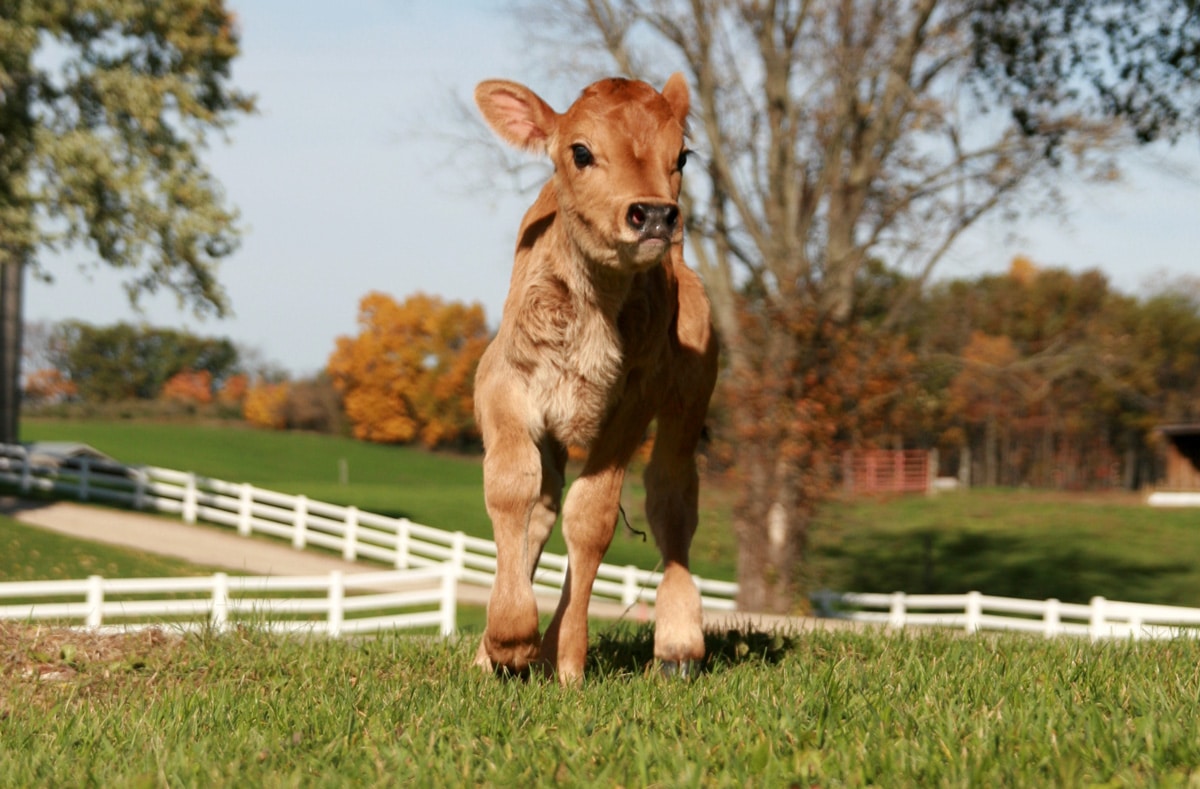
1. Prepare the Nursery
Make sure Jersey calves are born in a warm, dry environment to prevent their body temperatures from falling quickly. Regardless of the temperature, dry them quickly to slow loss of body heat. In cool weather (≤ 50˚F), place them in a calf warmer or other heated environment before moving them to their permanent hutch or calf pen. Ensure they have plenty of clean, dry straw to nest in. This will help them trap body heat and cope with chilly temperatures. Also consider the use of calf blankets or jackets as soon as they are dry.
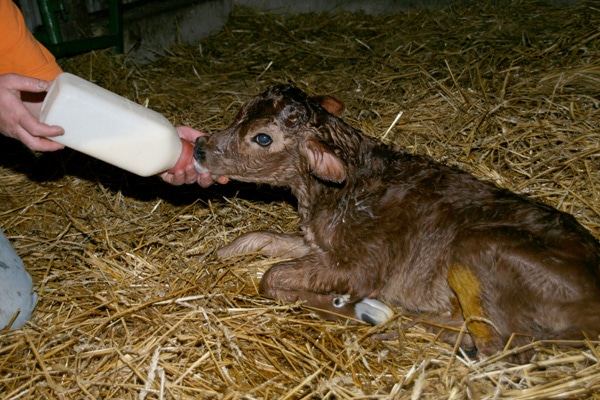
2. Boost Immunity with Colostrum
Get colostrum into your calves quickly and in adequate amounts to develop passive immunity. The value of this single act cannot be stressed enough as a contributor to more efficient growth rates, higher production, and lower veterinary bills over the course of the animal’s life.
Colostrum should be warm (100-105˚F) and fed to Jersey calves within two hours of birth at a rate of 3-4 quarts, or 10% of body weight. Feed an additional two quarts when the calf is 12 hours old. A third feeding of two quarts, if possible, is also recommended.
Immunoglobulin G (IgG) concentration is highest immediately after calving and declines markedly after six hours. So, it should be harvested as soon as possible, ideally within an hour. Use a colostrometer or Brix refractometer to evaluate IgG levels of colostrum. The gold standard is at least 50 mg./ml. for first feeding. Maintain cleanliness as high bacteria counts in colostrum impair absorption of IgG.
If an adequate supply of colostrum is not available or not of high enough quality, use milk from the first milking and supplement it with a colostrum enhancer (IgG). Look for a product that is made to “supplement” rather than “replace” colostrum and create milk that most closely resembles colostrum from the dam.
Colostrum replacers can also be used when colostrum supply is limited. Feed at least 150 grams of high-quality IgG during the first feeding.
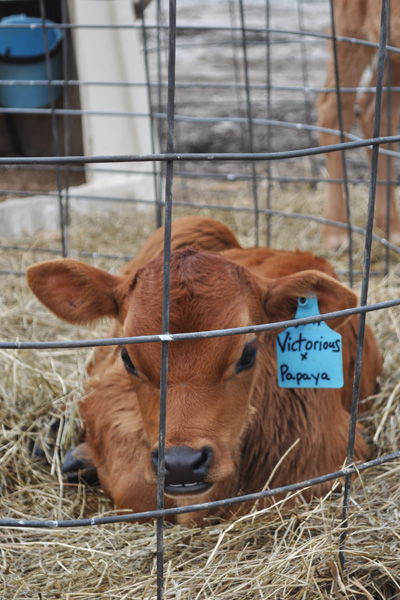
3. Control Pneumonia and Coccodiosis
Work with your veterinarian to develop a protocol that protects against the three major pneumonia-causing viral pathogens: bovine respiratory syncytial virus (BRSV), infectious bovine rhinotracheitis (IBR) virus, and parainfluenza 3 (PI3) in the pre-weaned calf.
As well, work with your veterinarian to develop a coccidiosis control program that makes sense for your farm.
4. Choose Your Milk Plan Wisely
If you use milk replacer, make sure it is designed for Jerseys. Research shows Jerseys need higher concentrations for both protein and fat in the liquid diet as indicated by the Land O’ Lakes Jersey Blend milk replacer. Optimum levels are 28% protein and 25% fat.
When choosing milk replacer, pay attention to quality of ingredients. For younger calves particularly, avoid milk replacers that have vegetable proteins, such as wheat gluten or soy flour. Until they are older, calves under 30 days-of-age lack the enzyme necessary to digest these ingredients effectively.
For the first week, feed Jersey calves up to two quarts of milk, three times daily (six quarts total). From weeks 2-6, feed them three quarts twice daily. From weeks 5-6, feed three quarts at least twice daily. For week seven, reduce intake by one quart per feeding. For week eight, feed once a day.
5. Feed More Often
Jerseys do well with smaller meals, more frequently. Smaller stomachs require more frequent feedings with smaller amounts. This is less stressful for the calf, particularly those under two weeks-of-age.
An automatic calf feeder is a management tool that allows dairy producers to feed more frequently with less labor. Calves housed in group pens on automatic feeders also transition to larger group setting more easily when weaned.
6. Listen to the Weatherman
Temperatures may be cool for Jerseys a better part of the year in parts of the U.S. So, be prepared to feed more energy to counteract heat loss and support normal growth. This is especially for calves under 21 days-of-age, who do not have the ability to regulate their own body temperatures.
Keep in mind, the lower end of the thermoneutral range for Jersey calves is 60˚F. Under this temperature, more energy is required to keep warm, directing nutrients away from growth. Visible shivering has been observed at 48˚F, even though their hair was dry, they were well fed, and the wind was calm.
This impacts a surprising number of domestic dairy producers. Across an average year in Minnesota, there will be 262 days under 60˚F. More surprising are the 181 days of sub-60˚F temperatures for Sacramento, Calif., each year.
When the temperature falls below 60˚F a Jersey calf needs more calories in her diet. The lower the temperature goes, the more calories she needs. In cold weather, increasing the feeding rate of milk or milk replacer can help the calf maintain her rate of gain. In the coldest months of the year, feeding calves more than twice a day may be necessary.
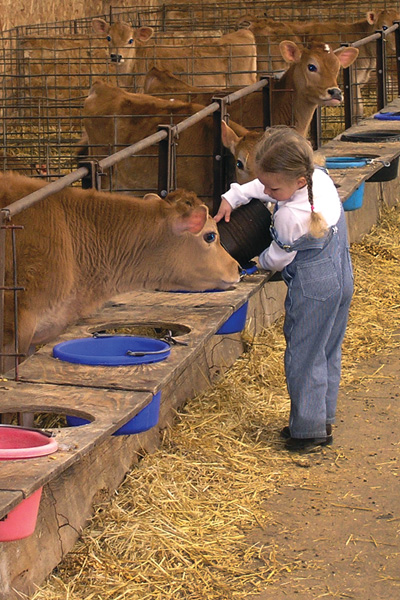
7. Offer Water and Calf Starter Early
Beginning at two days-of-age, offer free choice water and calf starter. Promote water intake, even during cold spells. Position water and feed buckets at least 12” apart so water remains fresh, clean and free of calf starter.
Consider feeding electrolytes between the two milk meals to keep calves hydrated and ward off disease.
Encourage consumption of a 22% protein calf feeder by offering a small handful in a bucket from day two. Replace uneaten starter daily.
Jersey calves will only consume a small amount of starter (≤.5 lbs.) each day for the first three weeks. They should be consuming 1.5-2.0 lbs. each day for three consecutive days before they are weaned.
8. Delay Feeding Hay
Consumption of dry feeds high in fermentable carbohydrates supports development of the rumen. Consumption of dry forages prior to weaning can delay rumen development due to its lower energy content.
To get the most production from your Jerseys in the milking string, do not offer hay to calves until two weeks after weaning. And then, feed a fine-stemmed grass hay. The small amount of fiber that calves need should be provided by the calf starter.
9. Be Patient with Transitions
Be more mindful about transitioning Jerseys from milk to feed. The transition from a milk-based diet to a post-weaned diet can be more difficult for Jerseys.
Some dairy producers may find their Jersey calves do well until weaning, then go into a growth slump that lasts 2-3 weeks. Prevent the stress that accompanies weaning by transitioning slowly. Two weeks before weaning, reduce the amount of milk fed at each meal, then feed once a day.
Make sure calves are eating 1.5-2 lbs. of calf starter each day. Remember, weaning cannot happen until the rumen is developed.
It may also help to transition calves from milk to feed by reducing fat levels in milk since it is satiating. By consuming less fat, calves will be hungrier and more apt to eat calf starter.
Though you should be mindful of starter intake, don’t worry too much about intake during the first month. Calves will grow more and be healthier with more milk. When milk is reduced at six weeks, they will be rapidly eating starter and be more successfully weaned.
During cold weather, weaning should probably be delayed until calves are 10 weeks-of-age.

10. Set Goals for Rate of Gain
To reach full genetic potential, aim for Jersey calves to double birth weight by 56 days. For a 60-pound Jersey newborn, this equates to an average daily gain of 1.1 lbs. until weaning. From there, set a goal to have heifers gain an average of 1.2 lbs. per day.
A useful tool for establishing benchmarks has been developed by the Bovine Alliance on Management and Nutrition, available online here.
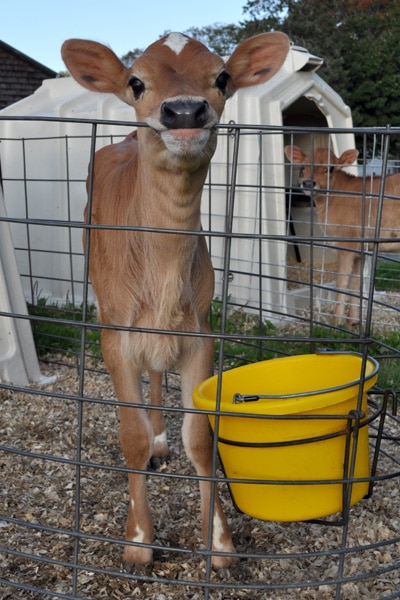
11. Follow the Mantra: Cleanliness is Godliness
Establish calf rearing protocol that enhances all your nutrition efforts. Make sure the whole house is in order, not just the diet. Wash feeding utensils daily (optimally after each feeding). Rinse in lukewarm water, then in warm soapy water. Allow them to air dry. Adopt consistent, regular feeding times. Practice good biosecurity. Make sure people handling calves wash their hands or use gloves before working with calves, especially if they have been doing tasks with the cows.
In Summary
Raising calves that become well-grown, productive milkers that express full genetic potential requires tender loving care from the onset. For success, use common sense, keep it simple and consider the five C’s of calf management―colostrum, cleanliness, comfort, calories, and consistency.
To get worksheets and other pertinent information on raising Jersey heifers, download the booklet, “Every Jersey Heifer, A Quality Heifer,” published by the American Jersey Cattle Association. Additional useful resources can be found in this booklet as well.
Or, watch a YouTube video on raising Jersey calves, presented by National All-Jersey Inc. as one of four webinars on Jersey nutrition.
Calf Raising Tips from the Experts
Tips from Scott Bascom, Edgerton, Wis. Scott is the dairy technology manager at Phibro Animal Health, serving clients in south central Wisconsin. He also has experience with several other dairy nutrition companies over a 17-year career in dairy nutrition. As a graduate student at Virginia Tech, he conducted research that led to the development of Land O’Lakes Jersey Blend. He grew up on a Registered Jersey farm and continues to be involved with the breed.
Keep Them Warm
- Use calf jackets to help Jerseys maintain body heat. When you put a jacket on a Jersey, it is like turning up the barn thermostat 25˚F.
- Make a straw nest for Jerseys to nestle in, especially from birth through the first two weeks. How do you know when you have used? When it is deep enough to completely cover most of her body when she lays down, and all you can see is her head.
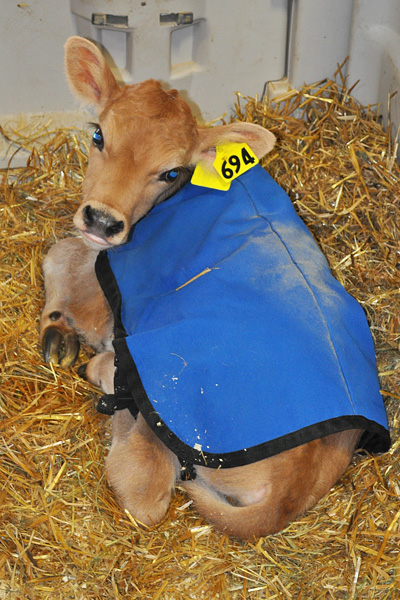
Develop a Back-up Plan for Colostrum
- Freeze excess colostrum in one-quart plastic bags so it can be thawed quickly in emergencies.
- Keep on hand a high-quality colostrum replacer that will deliver at least 150 grams of IgG in a single feeding.
Rename Colostrum “Miracle Food”
- Though many understand the value of colostrum for first feeding to develop passive immunity, colostrum has many bioactive compounds that benefit the calf. Research shows improved health and growth from feeding calves second and third milkings on days 2-3 of life.
Keep Them Hydrated
- When managing dehydration, an ounce of prevention is worth a pound of cure. Keep in mind, protocol to prevent dehydration looks different than protocol to treat dehydration. In many cases, products designed to treat hydration are not the best ones to prevent dehydration. The best electrolytes to prevent dehydration are palatable, inexpensive, and easy to deliver. Offer them the first two weeks of life, when calves are most stressed. Work with your veterinarian to identify the right electrolyte and protocol to treat dehydration.
- When temperatures are below freezing, feed lukewarm water after milk replacer to encourage drinking. Calves like warm water and, if thirsty, will consume a healthy dose right after feeding. If water in pails is expected to freeze after feeding, dump it immediately after a calf has drank as much as she wants.
Tips from Dana Empet, Kingsley, Pa. Dana has worked in the feed industry as a dairy technical support specialist and nutritionist in the northeast for the past 20 years. She formed Empet Dairy Consulting 10 years ago after working as a calf and heifer specialist for Land O’ Lakes Purina Feed. Dana and her husband, Rick, have 300 head of dairy cattle on their farm, where they milk Holsteins, Jerseys and Guernseys. Jerseys represent about 15% of the herd. Rick and Dana’s three children are the sixth generation of their family to raise Jerseys.
Use Calf Weaning Ring for Problem Children
- Jerseys are notoriously oral animals and Jersey calves love to such on each other. Keep an eye on calves who are group housed as babies or weaned calves. Identify problem calves and use calf weaning rings to deter calves from cross-suckling.
Use Milk Replacer Specially Designed for Jerseys
- Feed milk replacer to Jerseys that closely mimics milk components that would be provided by their dams. Strive for energy dense milk replacer with fat levels above 20%. The extra calories are needed, especially in colder weather.
Feed Higher Rates of Milk Replacer
- Jersey calves can be fed intensified feeding programs that include higher rates of milk or milk replacer as they grow. Consider the size of the calf, though, when determining feeding rates and gradually step up to this amount. Too much too quickly can cause calves to scour. Feed additional milk for the first feeding for several days, then increase the amount fed at the second feeding.
Watch the Calving Pens
- It is critical to prevent newborns from being chilled during the first 48 hours of life. Make sure maternity pens are clean and dry BEFORE the calf is born. Allow the mother to lick the calf off after birth to dry its hair and support blood circulation. If the mother does not or cannot do this, step in and dry the calf off with a towel and use a warming box.
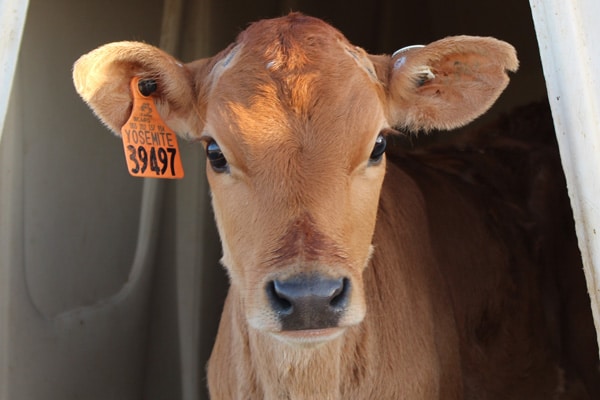
Tips from Gary Moore, Greenwich, N.Y. Gary has worked in dairy nutrition for more than 30 years, initially with Cargill Animal Nutrition and now with Denkavit. The past 15, he has specialized in calves and heifers. He also operates a 45-cow herd of Registered Jerseys and Holsteins with his family.
Pay Attention to Total Intake
- While it is paramount to get nutrients into the Jersey calf, total intake may be reduced when fat levels are too high because fat is satiating. When the amount of fat in milk replacer is reduced slightly, space is freed to add more lactose, and calves will drink more. They do not have to drink much more milk to offset the reduced digestible energy from fat if the milk replacer is formulated with the right ingredients and the right process. Intake can also be reduced when solids are too high. Shoot for a range of 13.5-14.5% for the first three weeks and let calves drink more if they want to.
Be Mindful of Ingredient Quality
- Of more significance than crude protein level is the amount that can be utilized. With the right nutrition formula, a calf starter with 18-22% of protein may be more useful than one with 19-22%. Research as much as you can to know what you are buying.
